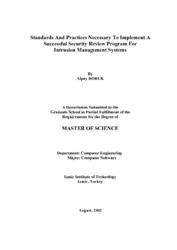Please use this identifier to cite or link to this item:
https://hdl.handle.net/11147/3706Full metadata record
| DC Field | Value | Language |
|---|---|---|
| dc.contributor.advisor | Tuğlular, Tuğkan | - |
| dc.contributor.author | Doruk, Alpay | - |
| dc.date.accessioned | 2014-07-22T13:52:11Z | - |
| dc.date.available | 2014-07-22T13:52:11Z | - |
| dc.date.issued | 2002 | - |
| dc.identifier.uri | http://hdl.handle.net/11147/3706 | - |
| dc.description | Thesis (Master)--Izmir Institute of Technology, Computer Engineering, Izmir, 2002 | en_US |
| dc.description | Includes bibliographical references (leaves: 84-85) | en_US |
| dc.description | Text in English; Abstract: Turkish and English | en_US |
| dc.description | viii, 91 leaves | en_US |
| dc.description.abstract | Intrusion Management Systems are being used to prevent the information systems from successful intrusions and their consequences. They also have detection features. They try to detect intrusions, which have passed the implemented measures. Also the recovery of the system after a successful intrusion is made by the Intrusion Management Systems. The investigation of the intrusion is made by Intrusion Management Systems also. These functions can be existent in an intrusion management system model, which has a four layers architecture. The layers of the model are avoidance, assurance, detection and recovery. At the avoidance layer necessary policies, standards and practices are implemented to prevent the information system from successful intrusions. At the avoidance layer, the effectiveness of implemented measures are measured by some test and reviews. At the detection layer the identification of an intrusion or intrusion attempt is made in the real time. The recovery layer is responsible from restoring the information system after a successful intrusion. It has also functions to investigate the intrusion. Intrusion Management Systems are used to protect information and computer assets from intrusions. An organization aiming to protect its assets must use such a system. After the implementation of the system, continuous reviews must be conducted in order to ensure the effectiveness of the measures taken. Such a review can achieve its goal by using principles and standards. In this thesis, the principles necessary to implement a successful review program for Intrusion Management Systems have been developed in the guidance of Generally Accepted System Security Principles (GASSP). These example principles are developed for tools of each Intrusion Management System layer. These tools are firewalls for avoidance layer, vulnerability scanners for assurance layer, intrusion detection systems for detection layer and integrity checkers for recovery layer of Intrusion Management Systems. | en_US |
| dc.language.iso | en | en_US |
| dc.publisher | Izmir Institute of Technology | en_US |
| dc.rights | info:eu-repo/semantics/openAccess | en_US |
| dc.subject.lcc | TK5105.59 D67 2002 | en |
| dc.subject.lcsh | Computer networks--Security measures | en |
| dc.subject.lcsh | Firewalls (Computer security) | en |
| dc.title | Standards and Practices Necessary To Implement a Successful Security Review Program for Intrusion Management Systems | en_US |
| dc.type | Master Thesis | en_US |
| dc.institutionauthor | Doruk, Alpay | - |
| dc.department | Thesis (Master)--İzmir Institute of Technology, Computer Engineering | en_US |
| dc.relation.publicationcategory | Tez | en_US |
| dc.identifier.wosquality | N/A | - |
| dc.identifier.scopusquality | N/A | - |
| item.languageiso639-1 | en | - |
| item.grantfulltext | open | - |
| item.fulltext | With Fulltext | - |
| item.openairecristype | http://purl.org/coar/resource_type/c_18cf | - |
| item.openairetype | Master Thesis | - |
| item.cerifentitytype | Publications | - |
| Appears in Collections: | Master Degree / Yüksek Lisans Tezleri | |
Files in This Item:
| File | Description | Size | Format | |
|---|---|---|---|---|
| T000125.pdf | MasterThesis | 511.12 kB | Adobe PDF |  View/Open |
CORE Recommender
Page view(s)
192
checked on Jun 10, 2025
Download(s)
110
checked on Jun 10, 2025
Google ScholarTM
Check
Items in GCRIS Repository are protected by copyright, with all rights reserved, unless otherwise indicated.